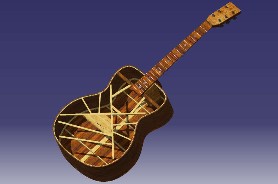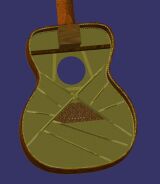The Virtual Guitar
The Virtual Guitar is a finite element model, created using the software system CATIA V5. This modelling tool is used to describe the geometry and the distribution of the internal braces and to analyse the vibration of the structure of an acoustic guitar. The guitar modelled is the OOO model produced by Gilet Guitars in Sydney, which is one of the laborotory's industrial supporters.
 
In the left image, the top plate has been rendered transparent to show the internal bracing, and in the right image the bottom plate has been rendered transparent.
Vibration Analysis
This image shows the (0,0) mode for a free guitar. The amplitude is exaggerated so that it can be seen and the maximum amplitudes are colour coded. All positions are given with respect to the resting positions of the strings, which is why the strings seem to remain stationary in the image. The strings are modelled with their measured stiffness, the wood is modelled using measured values of the elastic moduli.
In the images below, several approximations are made, so these should be considered as qualitative behaviour only. (For more information about the naming of modes, see Chladni patterns.)
Free guitar, (0,0) mode
Free guitar, (0,1) mode
Played guitars are not free--no-one has taken a guitar to the space station yet! Clamping the back plate is an approximation of what happens when the instrument is held against the player's body.
Back plate clamped, (0,0) mode
Back plate clamped, (1,0) mode
Back plate clamped, (0,1) mode
This is the work of Matthieu Maziere, Davy Laille, and David Vernet. They were all visiting students who did this work as a practicum project at UNSW.
Back to Guitar Acoustics |

